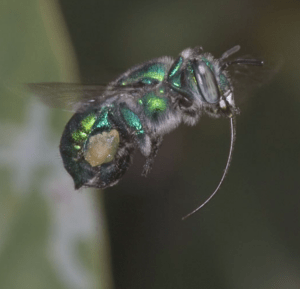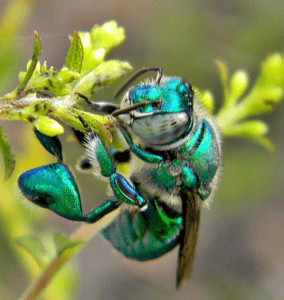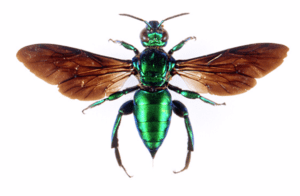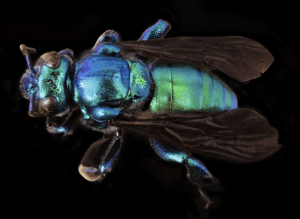I’ve spent over 6 weeks in Costa Rica over the past three years volunteering on a native bee research project with a Dr. Gordon
Frankie from UC Berkley. Tropical bees are very different from those we find around here in Maryland. The most common bees in the tropics are stingless bees which form colonies and tend to be very small bees. Oil bees are common in the tropics and I’ve written about them before. Another common group of bees found in the tropics are the Orchid bees which are in the taxonomic tribe of Euglossini bees which contain 5 different genera and a total of about 190 different species of bees (Picture 1).
Orchid bees get their name from the fact that the male Orchid bees collect oil from Orchid flowers and store it inside of their hind legs (Picture 2). Entomologist are not 100% sure why male Orchid bees collect these oil, but it’s assumed by many that they use it to attract females for mating. The major problem with this theory is that you can use a variety of scented materials to attach male Orchid bees, but these scents never attach female Orchid bees.
On my last trip to Costa Rica, I wanted to attract one of the large male Orchid bees from the genus Exaerete (Picture 3) which is a cleptoparasitic genus which is considered to be rare in the area of Costa Rica that I was visiting. Cleptoparasitic bees are bees that don’t collect their own
pollen, but steal pollen collected by other bees to use in rearing their young. A cleptoparasitic bee will sneak into the nest of its host bee and lay its egg on the pollen mass collected by the host bee. When the larva of the cleptoparasitic bee emerges, it kills the host egg/larva and eats all the pollen. It has been well established which scents can be used to attach male Orchid bees of different species and I got these compounds together before I left for Costa Rica (Picture 4).
The most commonly used scents are oil of wintergreen, vanilla, and eugenol (which is oil of clove). While out in the field, I set up my scent baits by putting some of the oils on cotton swabs in a shaded area next to a stream. I was warned not to get the oils on myself, on my netting or on the ground as that would then also become an attractant site for the male Orchid bees. Well, it did not take long for male Orchid bees to show up at my scent baits, less than 5 minutes after putting out the scents, I had my first male Orchid bees arrive. It took a little longer but I was rewarded with several of the large cleptoparasitic male bees did show up and I was able to net 3 of them. It’s strange how at the age of 56, the little things in life can make you feel like a kid all over again. My heart was pounding out of my chest and all I had done was catch a bee! I had the added pleasure of showing my catch off to the two guys that had been working in the area since the mid 1960’s and had never seen one of these large Exaerete bees in the area (they also had never spend the time looking for them either).
When back at my room, and under my microscope (yes, I’m a real geek, I travel with a microscope)
I IDed by bee as an Exaerete smaragdina (Picture No. 5). Never under estimate the power of the little things in life !!!






